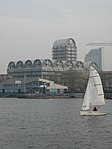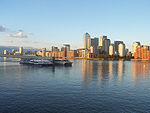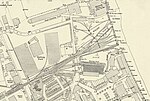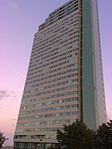South Dock, Rotherhithe
Buildings and structures in the London Borough of SouthwarkGeography of the London Borough of SouthwarkHistory of the London Borough of SouthwarkLondon docksMarinas in England ... and 9 more
Military history of LondonPort of LondonPorts and harbours of the Thames EstuaryRedeveloped ports and waterfronts in LondonRedevelopment projects in LondonRotherhitheShipbuilding in LondonShipyards on the River ThamesUse British English from May 2017
South Dock is one of two surviving docks in the former Surrey Commercial Docks in Rotherhithe, London, England. It was built in 1807–1811 just south of the larger Greenland Dock, to which it is connected by a channel now known as Greenland Cut; it also has a lock giving access to the River Thames. Originally named the East Country Dock, it was renamed in 1850 when the Surrey Commercial Dock Company purchased and enlarged it. Timber and grain were the main products imported and exported in the dock.
Excerpt from the Wikipedia article South Dock, Rotherhithe (License: CC BY-SA 3.0, Authors).South Dock, Rotherhithe
Rope Street, London Rotherhithe (London Borough of Southwark)
Geographical coordinates (GPS) Address Nearby Places Show on map
Geographical coordinates (GPS)
| Latitude | Longitude |
|---|---|
| N 51.493422222222 ° | E -0.035769444444444 ° |
Address
South Dock Marina
Rope Street
SE16 7TY London, Rotherhithe (London Borough of Southwark)
England, United Kingdom
Open on Google Maps










